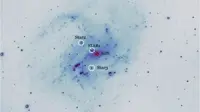Unexpected success for Phoenix Mars mission: ice may have been discovered
02 Jun 2008
Unexpected success may have come in the way of the Phoenix space mission to Mars as photographs indicate that the vehicle is standing on a patch of ice, making a discovery in days what experts had hoped to achieve in weeks, if at all.
Photos showing the ground beneath the Phoenix lander suggested the vehicle was resting on patches of ice, mission team members said on Friday. Scientists gave an updated assessment on Saturday after a more detailed image taken under the lander showed one of the craft's three legs sitting on coarse dirt and a large patch of what appears to be ice - possibly 90 centimetres in diameter.
A Washington University scientist and mission investigator, Ray Arvidson, said the spacecraft's thrusters might have blown away dirt covering the ice when it landed a week ago.
However, he expressed caution by adding, ''We could very well be seeing rock, or we could be seeing exposed ice in the retrorocket blast zone. We'll test the two ideas by getting more data.''
Phoenix's prime purpose is to seek out ice beneath the Martian surface and the robot spaceship is scheduled to spend the next three months on the surface of the planet searching for signs of water there. The prospect that the probe might have already succeeded, after only a few days on the planet, is causing considerable excitement among scientists. (See: NASA's Phoenix Mars Lander makes a successful landing)
The spacecraft is equipped with a robotic arm that will be used to dig and retrieve samples for testing in the lander's laboratories. The robot arm is expected to begin its first digging operations after several days of testing.
The spacecraft hopes to find out whether conditions conducive to life had ever existed on the red planet. The presence of organic samples in ice beneath the surface will also lend support to the inhabitable theory. (See: Spacecraft searching for life-like conditions set to land on Mars)









.webp)














